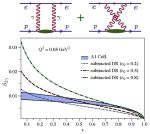EPJ A Highlight - Subtracted dispersion relation estimate of two-photon exchange
- Details
- Published on 05 March 2015

Elastic electron-proton scatterings (with one-photon exchange) have always provided fundamental information on general properties of the proton. Recently, two experimental approaches, with and without polarized protons, gave strikingly different results for the electric over magnetic proton form factor ratio. Similarly, a mysterious discrepancy (“the proton radius puzzle”) has been observed in the measurement of the proton charge radius in different experiments, one of which is electron-proton scattering. Two-photon exchange (TPE) contributions have been proposed as a plausible solution to resolve the puzzles, but their estimates have strong model dependences. A quantitative understanding of TPE effects, based on general principles and avoiding model dependences, is necessary. A subtracted dispersion relation formalism for the TPE has been developed and tested. Its relative effect δ2γ on the elastic cross section is in the 1-2 % range for a low value of the momentum transfer Q2 as function of the kinematic parameter ε, ranging between ε = 0 (backward scattering) and ε = 1 (forward scattering).
Summarizing, the paper studies in a theoretical framework which minimizes the model dependence, the TPE contributions to electron-proton scattering, a precision experiment crucial for measuring the most fundamental proton properties.
O. Tomalak and M. Vanderhaeghen (2015), Subtracted dispersion relation formalism for the two-photon exchange correction to elastic electron-proton scattering: Comparison with data, European Physical Journal A 51: 24, DOI 10.1140/epja/i2015-15024-1




